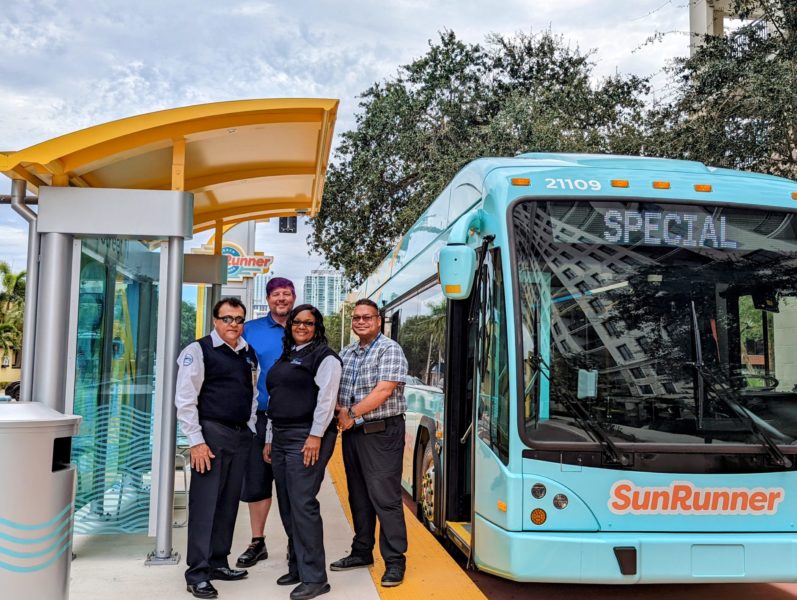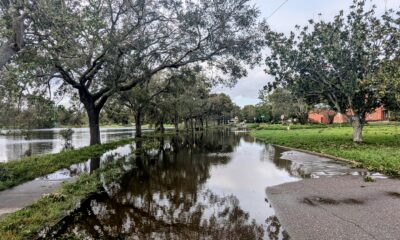How long can the SunRunner remain fare-free?

Business folks sporting blazers on their way to meet clients and tourists wearing boardshorts with beach bags in hand can continue to enjoy SunRunner fare-free for six more months, and potentially longer.
The Pinellas Suncoast Transit Authority’s SunRunner service, a 10.3-miles bus rapid transit line that travels through downtown and St. Pete Beach, was expected to end fare-free service in April. After seeing over 260,000 riders, PSTA is extending free service through November 2023 to collect more data and to educate riders.
“The extension of the free fares for an additional six months will encourage even more people to ride SunRunner and see for themselves how easy and convenient it is to use transit. This will enable us to continue to build our ridership and ensure the long-term success of the region’s first bus rapid transit line,” PSTA CEO Brad Miller told the St. Pete Catalyst.
During a Wednesday PSTA board meeting, Communications Director Whitney Fox informed the board the six-month extension is also crucial as PSTA will need to educate riders on how to pay for the SunRunner service when the fare-free term expires. The rest of the PSTA fleet accepts cash in addition to payments via the Flamingo Fares app, but SunRunner is cashless.
PSTA CFO Debbie Lewis estimates that the organization would lose $100,000 for the extended fare-free period which would double the estimated loss for SunRunner to $200,000 for the full year.
Board members Brian Scott and Chris Latvala cast the opposing votes against the fare-free strategy, noting the loss in revenue and questioning PSTA’s ability to collect fares.
“Transportation has a cost,” said Scott. “I think we should be collecting fares as soon as we possibly can.”
Fox noted that while PSTA could start collecting fares by April, when the fare-free service was originally scheduled to end, the payment system is not yet ready to accommodate riders with discounted fares, such as senior citizens and those who are disabled.
She added that many riders still pay with cash and need more time to be educated about utilizing the app for contactless payments.
Commissioner David Allbritton spoke on his support for the continuation of a fare-free service.
“Nothing is free, but PSTA is a public transportation [service] and more than the money, there’s the data for those six months. We’ve had this vetted through planning and finance,” Allbritton said, acknowledging the pros and cons weighed during the meeting.
“The bottom line for me is if we don’t have this data for the entire year, we are going to be guessing what ridership would’ve looked like,” commissioner Gina Driscoll said, voicing her support. “We have a precedent case study here with the Looper to show what kind of success it [fare-free service] is,” she said, adding that she may be including the recommended PSTA fare-free service in the city’s 2024 budget.
The downtown St. Pete Downtown Looper was fare-free, she pointed out, and experienced a 60% increase in ridership pre-pandemic.
Although not cited as a comparison during the meeting, the TECO Line Streetcar in Tampa is another example of how fare-free services have surged ridership.
The Streetcar went fare-free in 2018 thanks to a three-year, $67.3 million grant from the Florida Department of Transportation — the most for any transit project in the region’s history.
Two years later, the Streetcar, which runs 2.7 miles linking downtown Tampa to Ybor City, has surpassed over a million riders.
The discussion follows PSTA’s recent plan to add a new stop near the Pier since the overall project came in at 12.3% under budget, leaving $5.3 million in federal funds that PSTA is required to spend.
PSTA would work with Tampa-based design firm H.W. Lochner to design the new station if the Federal Transit Administration approves its plan. Lochner is the same group that designed the other existing 30 stations, and would replicate the current design.
The new station would be located on 1st Avenue N., near the Social Roost restaurant, a PSTA spokeswoman said.
The cost for a new station will not require the full $5.3 million. The spokeswoman said the board is considering additional options that would absorb the funds, including purchasing additional SunRunner buses or improving the communication technology at the stations.








Amber Bennett
February 27, 2023at3:33 pm
Looking forward to see how this progresses! I love the idea of residents and tourists having another means of affordable transportation.
Jack
February 26, 2023at12:00 pm
When you do the math, 260,000 riders in six months equals an average of 11 riders/bus. While every 15 minutes might be more convenient, every 30 minutes would be more cost effective.
Most people have clocks, watches and/or cell phones, so they can probably plan on when to be at their bus stop fairly accurately. If the buses are on time every time at every stop.
PSTA can offer free rides as long as they want, the average fare on the entire system is less than $1 due to discounts and free riders.
PSTA capital costs are 100% paid by taxpayers, over 90% of operating costs are paid by taxpayers.
Fares and other revenues account for less than 20% of operating costs.
Nothing is actually free, all those new buses and platforms were paid for – by taxpayers. Free Sunrunner fares are not free, taxpayers are paying the costs.
We can thank Ken Welch for creating yet another waste of taxpayers money as county commissioner who lost the Greenlight Pinellas vote in 2014. The Sunrunner is his scheme, literally rammed through by the county and Mayor Kriseman.
St. Pete Beach and S. Pasadena fought against it and did not pay a penny of the costs. But they got it through sheer skullduggery.
Welch and Kriseman even figured out a way to find the whole thing with our money without letting us vote on it. That was the final coup in the great Sunrunner debacle. The only problem is that we are paying for huge buses to run every 25 minutes 16 hours/day with an average of 11 riders. Too bad they did not understand that people are free to do what they want and they vote with their feet no matter what politicians want them to do.